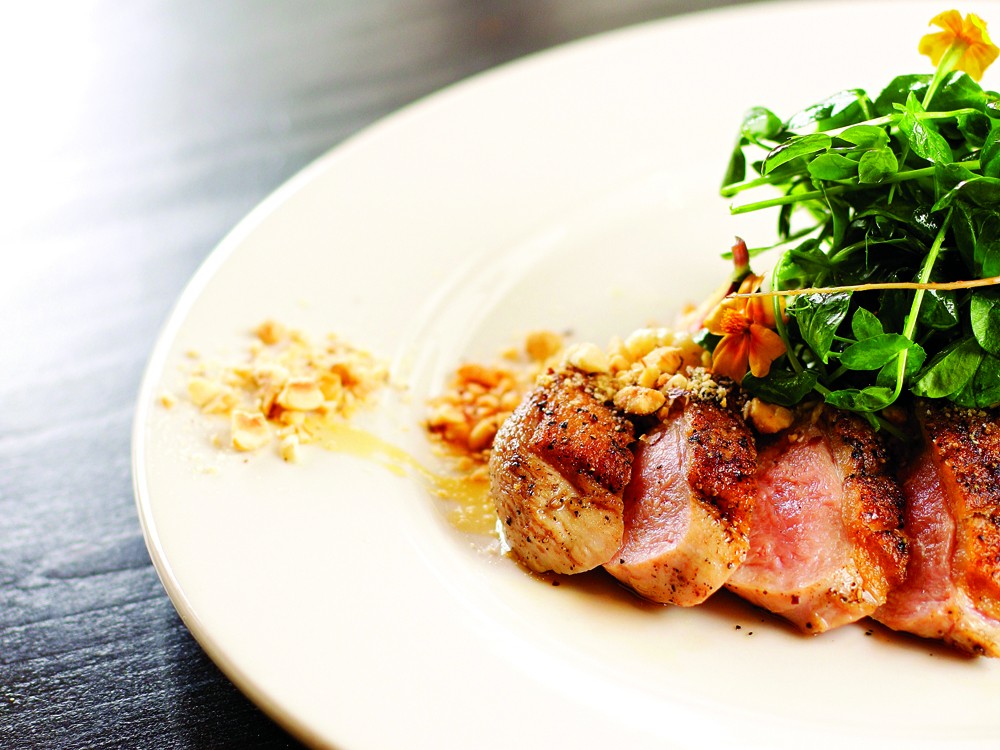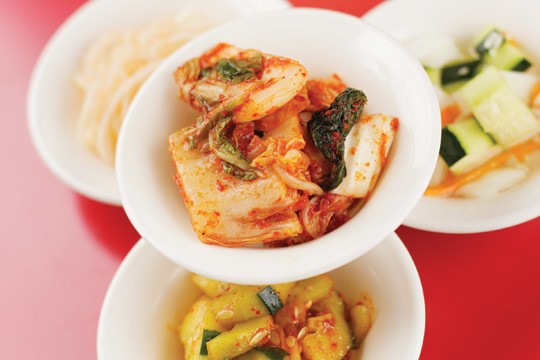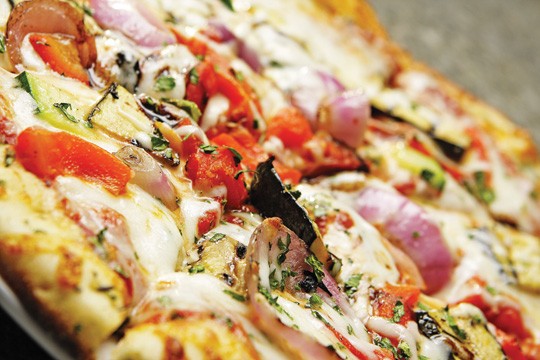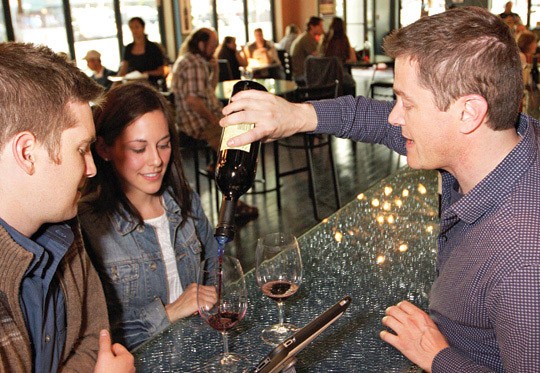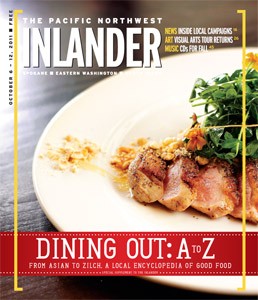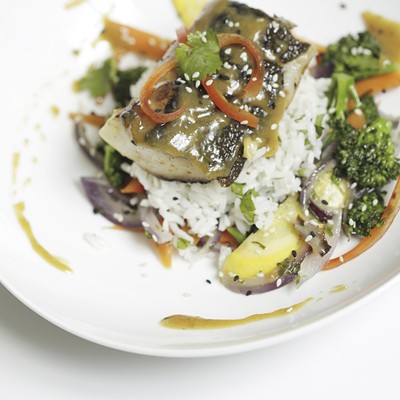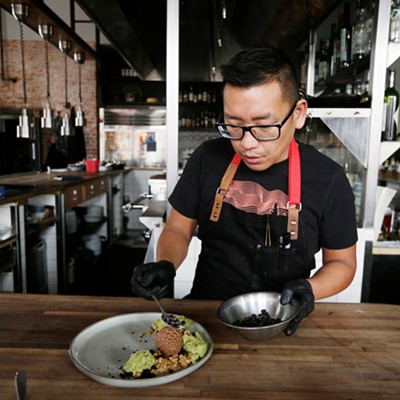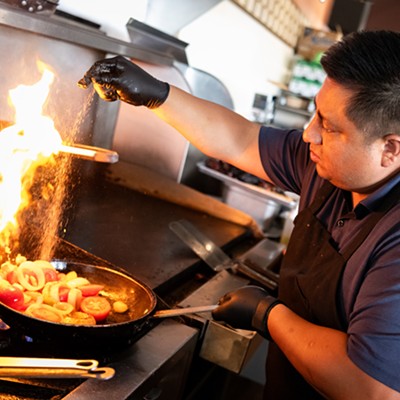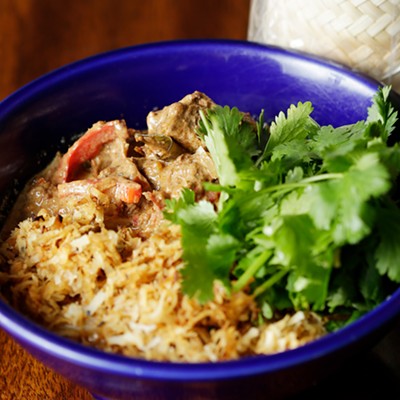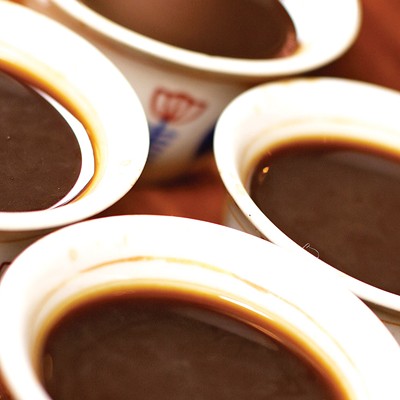Ketchup
condiment
1. Commonly: a tangy, sweet sauce made with vinegar, sugar, an assortment of spices and that most versatile of nightshades, the tomato (tom-ay-toe; alt: tom-ah-toe)
2. This
workmanlike, unassuming — even maligned — staple of the modern American
diet had a very public fall from grace, losing No. 1 condiment status in
the late ’90s to salsa. A reappraisal of middle-class cuisine among
serious chefs, though, along with a return to the culinary virtues and
cost-effectiveness of scratch preparation, has breathed new life — dare
we say, vigor — into this humble inhabitant of the American table.
Condiment
experimentation: Locally, Latah Bistro (4241 S. Cheney-Spokane Rd.)
makes its own tomato ketchup, along with a spicy yellow plum ketchup.
Chef David Blaine made a Filipino-style banana ketchup once, about six
years ago, but people weren’t ready for it. “People were so disturbed, I
started just sending tastes of the banana ketchup to tables while they
were looking at the menu.” With the recent proliferation of haute
condiments, though, maybe banana ketchup is an idea whose time has
finally come (again).
Eat at: Manito Tap House (3011 S. Grand Blvd.), Sante (404 W. Main Ave.), Savory (1314 S. Grand Blvd.).
—LUKE BAUMGARTEN
Korean
adjective
1. Cuisine of Korea, characterized by judicious use of spice (especially dried chili pepper), fermented vegetables (kimchee) and a million tiny little side plates (banchan) to go along with your main dish. The rise of the middle class in Korea has brought about more meat consumption and a proliferation of bulgogi, Korean barbecue. Bibimbap — originally a peasant’s staple dish of rice, vegetables and sometimes meat and an egg — has recently become hip locally.
2. Among the least well-known or understood forms of “Asian” food. Many ostensibly Korean restaurants pull double duty, offering sushi or teriyaki or Mongolian barbecue alongside their galbi.
Eat At: Kim’s Korean (1314 N. Division St.), House of Seoul (12721 W. 14th Ave., Airway Heights), HAHA’s Grill House (2710 E. Garland Ave.), Sushi Sakai (11520 E. Sprague), and Tokyo Seoul (905 E. Maple Ct, Pullman).
— LUKE BAUMGARTEN
Late-Night
useful to know
1. Period of eerie quiet in Spokane. You know how New York is “The City That Never Sleeps”? Spokane is the opposite of that. Come closing time at the bars, the nightlife slips into a coma.
Places open after hours: There are a couple of options for folks unwilling to step off the night train. Downtown Spokane staple the Satellite Diner (425 W. Sprague Ave.) is open until 4 am daily. At 1 am on a recent Thursday morning, server Isaac Lariviere was wide-awake, tending to his customers in the dimly lit booths under the Satellite’s vaulted ceiling, telling people to make sure the fries don’t burn. He guesses he’s been doing this shift for eight or nine years and says there’s something special about the late-night crowd.
“It’s just a nice atmosphere. Definitely more interesting.”
If you really want to see some interesting stuff, check out another late-night spot, Atilano’s Mexican Food (725 W. Third Ave). Some colorful characters in there. And fresh salsa.
— TIFFANY HARMS
Lengua
talking point
(leng-gwuh)
1. The tongue of a cow.
2. Fatty, tender, almost roast-beef-like meat featured in tacos at Mercado del Pueblo and elsewhere. Deli chef Hortencia Barba prepares the filling by peeling off the taste buds, lightly seasoning with bay leaf and slow-cooking it for two hours. The result is a simple taco garnished with diced onions and cilantro.
Eat at: Mercado del Pueblo (1814 N. Division St.), Tacos El Sol (First Avenue and Washington St.), Atilano’s (725 W. Third Ave.).
— ALICIA PURVIS-LARIVIERE
Mediterranean
region
1. If ever there were a more deceptive descriptor for cuisine, it’s this one. “Mediterranean” describes any area that borders the Mediterranean Sea. In this “cuisine,” goats and cheese are popular, as is olive oil and pita bread. They also dig the seafood, especially miniature squids. Sometimes, they dye pasta with their ink.
Eat at: Azar’s Greek Restaurant (2501 N. Monroe St.) has you covered here, as does the Taza Truck (Spokane Public Market, 24 W. Second Ave.). You can also check out Cafe Italiano (3331 W. Indian Trail Rd.) up north.
— TIFFANY HARMS
Mexican
adjective
1. Seasoned and simmered chicken smothered in spicy coffee-colored mole and wrapped up with rice and beans — now that’s a burrito. La Esquina (825 N. Monroe St.) makes their sauces and salsas from scratch daily, and the flavor really shines through. The carne asada — tender chunks of meat in a green cilantro and chili sauce — will leave you wanting more. We only wish the hours were longer — this little Mexican corner café does lunch only, including a buffet that offers a little of everything.
Eat at: When evening hunger hits, head for Agave Latin Bistro (830 W. Sprague Ave.) for Wild Boar Chili Verde or Tacos Tumbras (1325 W. Second Ave.) for a late-night beef huarache or cheap tacos. Stop by De Leon’s deli (102 E. Francis Ave.) for a breakfast burrito or grab a stack of housemade tortillas and a pound of carne asada to go. Order your holiday tamales by the dozen and pick up some sweet treats from the on-site bakery to go alongside.
— KIRSTEN HARRINGTON
Micro-Bars
phenomenon
1. Drinking establishments with a maxium capacity of typically fewer than 80 people. The bartender is often the owner, the maintenance man and the slinger of cheap beer all at once. Jeff Nordvall, owner of The Lantern Tavern (1004 S. Perry St.) in the Perry District, says his bar boasts 210 square feet on the inside, 135 square feet outside, and a maximum capacity of 49 people. “The most I’ve counted was 37 people in the bar one night,” he says. When asked if there was room to drink, he says they probably should have handed out straws.
2. Always looks packed and therefore walks a fine line with the fire marshall.
3. Where everybody knows your name, the name of your ex, and quite possibly the smell of your body odor.
Get comfortable with your neighbor at: Bon Bon (926 W. Garland Ave.), Baby Bar (827 W. First Ave.), the Riff (215 W. Main Ave.), El Que (141 S. Cannon St.).
— JORDY BYRD
Moroccan
cuisine
(mo-rockin')
1. Synonymous with finger food. Silverware is nowhere in sight. Instead, you use bread to scoop up the spiced dishes, consisting of things like veggies, lamb and lentils.
Eat at: Marrakesh (1227 N. Division St.) is our local tie to the cuisine of the north African country. Here you can score a five-course traditional Moroccan meal while seated in a tent-like room covered in lush fabrics. Also, you get to sit on pillows on the floor.
—TIFFANY HARMS
North Spokane
region
1. Area of the Inland Northwest’s largest metropolitan area characterized by split-level homes, long stop lights, strip malls and chain restaurants. This is a gross over-simplification. It is also mostly true, and becomes truer with greater distance from downtown.
2. The ’burbs.
3. The location of a recent food (semi-)renaissance: In the last decade, and increasing in frequency lately, higher-end, non-chain dining has come to the area.
Eat at: Downriver Grill (3315 W. Northwest Blvd.) and Marrakesh (1227 N. Division St.) further south. Since 2009, the far-north Wandermere area of Spokane County has bloomed with creative, thoughtful food options, including Wasabi (10208 N. Division St.), Rusty Roof’s (101 E. Hastings Rd.), Stix (9820 N. Nevada St.), Twigs (401 E. Farwell Rd. — it’s a chain, but it’s a local one, so they get a pass), and Petit Chat Bakery (9910 N. Waikiki Rd.).
— LUKE BAUMGARTEN
Octopus
cephalopod
1. Eight-legged sea beast that has mystified and terrified cultures everywhere. It’s understandable — they’re conniving and can walk on land, we hear. But the best way to stop being scared of them is to eat them. That’s what the Japanese, Koreans, Hawaiians and folks in the Mediterranean did, and they’re still stickin’ it to the octopus today.
Eat at: Any sushi place, and at Italia Trattoria (144 S. Cannon St.), when they have it on the menu. Release the Kraken!
— TIFFANY HARMS
Old Favorites
nostalgia
1. An old-time favorite depends a bit on how old you are and where you come from, and it can serve as a harbinger of what your future dinner plate may hold.
2. Frank’s Diner (1516 W. Second Ave.; 10929 N. Newport Hwy.) dishes up hash browns smothered in brown gravy and onions; Catacombs Pub (110 S. Monroe) serves s’mores that you can toast right at your table.
3. Perhaps nothing says “old-time favorite” like the humble grilled cheese sandwich. There are two types locally. The old-school construction of butter-slathered white bread with orange cheese innards, grilled warm and served via the drive-thru, has delighted generations of Zip’s (various locations) customers. But the sandwich goes gourmet at Mommy G’s Gourmet Grilled Cheese (corner of Washington and Sprague) food truck, where customers can choose between gruyere and havarti or sharp cheddar and habanero jack. There’s also a choice of breads and meats. If you can’t decide on just one, you can get three mini-sandwiches.
4. The meatloaf sandwich at Skyway Cafe (Felts Field, 6105 E. Rutter Ave.) and the broasted chicken from Maxwell House (1425 N. Ash St.) are time-tested local favorites that return you to youth and comfort. Some people may need a Chicken McNugget to return to that place of nostalgia. But for the love of all things taken or grown from the earth, let’s hope not.
— ANNEMARIE C. FROHNHOEFER
Pork Belly
noun
1. A boneless cut of fatty meat derived from the belly of a pig
2. Coeur d’Alene Casino chef Adam Hegsted likes this cut of pork because “fat equals flavor.” Pork belly doesn’t get the love it deserves, though, because diners aren’t familiar with it. Think bacon, only bigger. Who doesn’t love bacon?
Eat at: Santé (404 W. Main Ave.), where chef Jeremy Hansen braises it with chocolate, maple stock or Cajun seasoning and adds it to sandwiches, salads or macaroni and cheese.
— KIRSTEN HARRINGTON
Preserves
jarred deliciousness
1. The Spokane Regional Health Department wrapped hazard tape around Wild Sage (916 W. Second Ave.) five years ago. The incident (and the hazmat-like food handling and cleanup) was all because of a few jars of pickled green beans.
“At the time, they just didn’t know what to do with us,” says Charles Conner, executive chef at Wild Sage. “We were told complex restaurants such as ourselves couldn’t serve canned food.”
Today, the restaurant pickles its own green beans, asparagus and tomatillos as part of a tapas sampler. Instead of canning with sterilized jars in a high-pressure cooker, Conner says he brings white vinegar and pickling spices to a boil, then pours it over vegetables. He lets the concoction sit before refrigerating it. This fresh preserving process gives food a shorter shelf life, and the foods must be refrigerated.
Manito Tap House (3011 S. Grand Blvd.) uses similar practices for its pickled cauliflower, jalapeños, onions, pickles and pepper jelly. It’s a safe practice among restaurants that want to preserve food without falling into the gray area that plagues Washington state’s food safety policies and procedures.
Kristen Six, manager at Lovitt (149 Hwy. 395 S, Colville), says the health department’s big fear in regards to canning is botulism — a rare disease, caused by toxins in undercooked foods, that induces paralysis and respiratory failure. “It’s not such a bad fear,” Six says.
She adds that commercial restaurants are able to serve canned and preserved food if samples from each batch are sent to and approved by the Washington State Department of Agriculture.
To avoid the hassle, Lovitt fresh-preserves their lemon curd, jams, peaches, tomato pastes, syrups and pickled vegetables.
But Jeremy Hansen at Sante (404 W. Main Ave.) doesn’t flirt around the law. He cans and preserves his own meats, cucumbers, cornichons, radishes, jams and jellies in a traditional style. He says he preserves as much as possible to keep local food on his tables, to keep integrity in his business and to serve everything from scratch.
“You could call preserves a trend, because it’s definitely something that bigger cities are getting in to,” Hansen says. “But more than that, it’s a way of life.”
Hansen says he’s gone been back and forth with the health department over the legality of canning and preserves, but he’s not concerned. “They can come into my restaurant anytime,” he says. “They know what I’m doing and that I’m doing it safely.”
— JORDY BYRD
Pronunciation, correct
explanation
1. Coeur d’Alene Casino is fun and all, but it has restaurant names that are befuddling to pronounce. We investigated the Coeur d’Alene Tribe’s language, Schitsu’umsh, to clarify the pronunciation of its dining establishments — just so you don’t sound completely clueless when you call for reservations.
2. ts’elusm [tsell-OOS-m]: This term roughly translates to “They stand before the fire” and refers to a cooking technique in which food was cooked over an open fire, which is why this is a fitting name for their steakhouse.
3. hn’ya’)pqi’n’n [hin-yawp-KEEN-n]: This word means “a place for assembly.” Fittingly, this is the name of the sports bar.
4.
welukws [weh-LUKES]: This is the name of a blackjack-esque card game
mostly played by grandmas. This is the name of their quiet bar.
Go hungry to: Coeur d’Alene Casino (37914 S. Nukwalqw Rd., Worley, Idaho).
— TIFFANY HARMS
Quail
poultry
1. When American colonists found small, short-winged birds that preferred the ground to the sky, they were reminded of the quail they’d seen (and eaten) in Europe. With little imagination, they gave the birds the same name.
2. We now know that while the New World quail and Old World quail are distantly related, they are not the same bird. Because of their size, quail on both continents are commonly eaten on the bone, and the meat is dense but tender without a gamey flavor.
Eat at: Beverly’s at the Coeur d’Alene Resort (115 S. Second St., CdA) serves quail at dinner in pinot noir syrup with squab in a cherry balsamic vinaigrette and quail eggs at lunch in a seafood salad. At Ts’elusm Steakhouse (Coeur d’Alene Casino, see “Pronunciation”), it’s flame-broiled over pine needles with zinfandel glaze and local huckleberries. Ts’elusm’s quail come from a farm in South Carolina, but the idea is to put together on the plate plants, animals and fruits that live together in the wilds of the Northwest.
— LYDIA ZURAW
Quinoa
noun (keen-wah)
1. Edible, gluten-free, grain-like crop grown primarily for its edible seeds.
2. Can taste a little like dirt and/or mulch if you’re not careful to spice it up.
3. A complete protein source — meaning it contains all nine essential amino acids — making it a vegetarian superfood.
Eat at: Main Market Co-op (44 W. Main Ave.), where it’s served in a cold salad with tomato, cucumber, artichoke hearts, arugula, basil, parsley, red wine vinegar, carrots and chives. At Huckleberry’s 9th Street Bistro (926 S. Monroe St.), quinoa is served with grilled mangos, scallions, red peppers, red onions and curry citrus vinaigrette.
— JORDY BYRD
Rogers, Bob
chef
1. Less than a year after opening, Masselow’s restaurant at Northern Quest Resort and Casino garnered the coveted AAA Four Diamond Award for excellence in fine dining, making it the only restaurant in Eastern Washington to earn such a distinction. The man behind the scenes is Chef Bob Rogers.
“It starts with the quality of the ingredients and the love that goes into it,” he explains. If Rogers isn’t happy with a product, his kitchen makes it, from bread and crackers to sausage and mayo. And if he can’t make it, he’ll grow it. Last spring, Rogers planted seeds alongside local farmer Dan Jackson (see “Jackson, Dan”) for the heirloom tomatoes served at Masselow’s.
“The most exciting part of my job is teaching and developing young people,” says Rogers. “Our industry has really gotten away from making things from scratch the way we used to.” He works with his staff, teaching them everything from how to de-bone a chicken to making a proper beef stock.
When he’s not mentoring his staff at Masselow’s, Rogers volunteers with students at Shadle Park High School in the National Restaurant Association’s ProStart program. The two-year program is like a modern-day Home Economics class — kids learn organizational skills in the classroom and spend time in the kitchen preparing for future careers in the culinary arts. Rogers coached a team of five students in a statewide competition last year, turning out maple-truffle glazed pork chops, a pear salad and dessert in under an hour to take second place out of 17 teams.
Over the course of his career, Rogers has been involved in just about every charitable culinary event in Spokane, from Epicurean Delight to March of Dimes.
“I’m born and raised here,” he says, “so it’s pretty cool to be able to give back.”
Eat at: Masselow’s (Northern Quest Casino, 100 N. Hayford Rd., Airway Heights).
— KIRSTEN HARRINGTON
Savory Cocktails
noun
1. If James Bond knew that gummy bears had found their way into freakin’ martinis, he’d switch to Coors Light right then and there. There’s just no sense in this sweet cocktail business. We welcome the revival of savory cocktails, because drinks don’t have to be sweet to be delicious.
For something less tart: In Spokane, Lindaman’s (1235 S. Grand Blvd.), on the South Hill, offers a basil lime gimlet, made with gin (the arch-nemesis of fruity, sugary mixers), lime and fresh basil. Also, this is one of their strongest drinks.
If you want several dozen
more options, though, it’s probably best to just head over to the booze
specialists at Bardenay (1710 W. Riverstone Dr., CdA). The drink menu
takes about 10 minutes to look over, and even then you realize you’ve
only just seen the tip of the ice cube. In addition to an exhaustive
list of spirits (some fetching upwards of $50 for one glass), they also
work the cocktail angle, and they aren’t shy about treading into savory
territory. Try the Greek cocktail, which consists of Absolut Peppar,
Crown Royal, Clamato, and a bit of banana pepper juice. It’s garnished
with a banana pepper.
Eat your heart out, Carrie Bradshaw.
— TIFFANY HARMS
Seafood
noun
1. In downtown Spokane, head to Anthony’s and sip a cocktail on the patio and nosh on mahi mahi tacos or slip into a booth and celebrate life with lobster and champagne. Drink in views of the falls with consistently fresh seafood paired with Green Bluff produce. Valet parking and sunset dinner specials make Anthony’s (501 N. Lincoln St.) a winning choice. With three decades of experience, nearby Milford’s (719 N. Monroe St.) combines old-world charm with updated specials like Thai crisped catfish and grilled salmon bellies. If it’s sushi you’re after, pop into Sushi Maru (808 W. Main Ave.) in River Park Square for conveyor-belt sushi, or head up to the South Hill for Sushi I’s (4314 S. Regal St.) artistically presented nigiri sushi or value-priced salmon teriyaki bento box.
For more of an adventure, arrive by boat at Cedar’s Floating Restaurant (1514 S. Marina Dr.) in Coeur d’Alene and tuck into some Idaho trout or head into the forest for crab cakes and oysters Rockefeller at Chef in the Forest (12008 N. Woodland Beach Dr., Hauser, Idaho).
— KIRSTEN HARRINGTON
Soda, Homemade
noun
1. Remember when soda was made with actual sugar? Neither do I. Pathetically enough, in our modern, corn syrup-saturated society, there are fewer and fewer who do. Hidden in the labyrinthine Coeur D’Alene Casino, Hn’ya’(pqi’n’n (see also “Pronunciation”) kicks out classy twists on American staples — BLTs, pretzels, chicken wings — so it only seems natural to wash down one’s foie gras aioli-slathered burger with a locally sourced, scratch-made concoction.
The method that sous chef Matt Mayer uses is the same one that soda fountains and ice cream parlors used from the 1930s until their eventual demise in the 1960s. Mayer steeps ginger and vanilla pods in a pot of hot sugary syrup to allow maximum absorption of flavor. The mixture is then strained, cooled and dispensed accordingly in an old-style dispensing tank. Mayer serves up tall glasses of yesteryear in huckleberry, root beer and ginger-and-vanilla-cream flavors.
Try at: Hn’ya’(pqi’n’n - A Gathering Place (37914 S. Nukwalqw Rd., Worley, Idaho).
— ALICIA PURVIS-LARIVIERE
Tea Service
ceremony
1. Tea time is a time to slow down and relax, a time for an unhurried meal, to chat and seek refuge while the tea leaves steep.
“It’s so different from anything else Americans do, because we are so fast-paced,” says Dawn Kiki, owner of Brambleberry Cottage & Tea Shoppe (206 E. Pacific Ave.). “We just expect to walk into a place, get our food and eat it and run.”
Brambleberry opened 16 years ago as a painting studio and evolved into the by-reservation tea shop that it is today serving 60 flavors of tea and refreshments.
Most Americans consider afternoon tea to be the same thing as high tea, but the two are not interchangeable terms.
Traditionally, high tea was a “working man’s supper” for the whole family, while afternoon tea was light refreshment to stave off hunger until the late dinner. Tea was around long before it became associated with the English, but it was Anna Russell, Duchess of Bedford, who popularized afternoon tea during the 18th century.
Even though tea is the second-most-consumed beverage in the world, after water, it wasn’t very popular in America after the Boston Tea Party, Kiki explains.
Every tea shop serves their own version of afternoon tea, and Kiki makes a point of having tea everywhere she goes, to see how others do it.
But tea service is not a very lucrative business. Kiki has seen about 10 shops in the area come and go in recent years, and even she admits she doesn’t really make a profit. But she stays open because she loves it and the service it provides to the community.
“What I find continually pleasing is that someone can come in who’s having the worst day, and when they leave, they’re just so happy,” she says. “They’re so much more peaceful, because it’s completely changed their demeanor.”
— LYDIA ZURAW
Thai
cuisine
(tie)1. The cuisine of Thailand. Aromatic and often quite spicy, it makes judicious use of ginger, red chiles, tamarind, lemongrass, Thai basil, mint and lime.
2. Though highly regionalized in-country (and in other, more diverse metro areas), locally Thai tends to be a greatest-hits assortment from across the country. Example: Curries tend to use coconut milk, common to the south, while pad thai is garnished with lime, indicative of the northeast.
Eat at: Sala Thai (12924 W. Sunset Hwy.), Bangkok Thai (1325 S. Grand Blvd.), Phonthip Style Thai (1006 E. Francis Ave.), Savanny Thai Cuisine (11808 E. Sprague Ave., Spokane Valley) Secret Thai Café (218 Cedar St., Sandpoint).
— LUKE BAUMGARTEN
Tofu
alternative
1. Bean curd fashioned into soft white blocks. It gets a bad rap, and most of the time the criticism is deserved. Good tofu — the kind that isn’t slimy, isn’t too chewy, and doesn’t taste like wet cardboard — is hard to come by.
Eat at: Neato Burrito (827 W. First Ave.) does tofu right. The ground tofu is slightly spicy and savory — rumor has it’s because of soy sauce — and it’s the perfect filler to a quesadilla or massive burrito. The curry bowl at Picabu Bistro (901 W. 14th Ave.) is a nice blend of mixed vegetables and tofu in a spicy red curry peanut sauce. Mix that with cilantro and jasmine rice, and the sweetened tofu will melt in your mouth. For something fancy, try the almond- and herb-crusted Small Planet Tofu at Mizuna (214 N. Howard St.). Chef Tony Brown serves it almost like a steak — it’s marinated with a delicate mushroom and cherry tomato broth. Top it off with jasmine rice and cabbage slaw and you’ll forget what meat ever tasted like.
— JORDY BYRD
Underground Dining
relative elevation
1. Consuming food and drink in a locale that is neither at nor above ground level.
2. A class of restaurant that exists independent of cuisine type or any of the other usual taxonomic categories of food, but rather hones in on the common human urge to hole up in a dark-ass place — preferably with some sort of exposed brickwork and a healthy wine list — and either make out with someone or brood alone.
Trip downstairs to: Catacombs (110 S. Monroe St.), Steam Plant Grill Lounge (159 S. Lincoln St.), Churchill’s Lounge (165 S. Post St), the Wine Cellar (313 E. Sherman Ave, CdA) and, soon to open, the Vault (120 N. Wall St.).
— LUKE BAUMGARTEN
Vegan
adjective
1. A diet and lifestyle in which all animal products are avoided — no dairy, no meat and no animal byproducts. Often, a vegan will abstain from purchasing leather shoes, drinking wine produced with isinglass (fish bladders) or even consuming honey.
2. The lifestyle that was once only for hippies and the lactose-intolerant has seriously mainstreamed in recent years. Proof: Ellen Degeneres is a proud vegan. Bill Clinton is a freaking vegan. When an ex-president and a daytime talk show host are going meat-free, dairy-free, that’s when you know shit’s catching on.
Being vegan, though, means being flexible — and the Inland Northwest is spotty for vegan options. Ethnic fare like Indian and Ethiopian — cuisines rooted in vegetarianism — are great for vegan options. On the fancier end of things, downtown’s Mizuna artfully caters to the meat-free population with its mouth-watering vegetarian menu, with lots of vegan options.
At the twinkle-light and gilded Buddha-filled north-side Red Dragon location, a small but strong vegan menu offers options that can rarely be found elsewhere. Owner Will Burris says his decision to have a vegan menu simply happened because he had waitresses on staff who were vegan.
“I started making vegan dishes for the waitresses and selling it to people who asked for it,” he says. “Then more people started coming in. … Here’s an interesting group of people who have nowhere to eat.” And a vegan menu was born.
At Red Dragon, vegan-friendly wonton soup ($8.50) is served in more of a vat than a bowl. The soup is salty, spicy and sweet. Halved button mushrooms bob in the mock-beef broth alongside garden-fresh broccoli, cabbage and snap peas. And Burris doesn’t skimp on the wontons. In one bowl, there could be more than six or seven, filled with pan-fried veggies and vegan beef.
You can get the full Chinese food experience there, too — fried spring rolls, potstickers and sesame balls (filled with sweet black sesame paste) are animal-free options. Vegans can add seitan, tempeh or tofu to any dish.
Of course, the doors of Red Dragon are hardly being knocked down by vegans right now (on our visit, our waitress raised her eyebrows: “Seitan? What now?”), but with more and more diners choosing healthy, animal-free diets, Hillyard might soon become a hub for vegans. And who would have ever seen that coming?
Eat at: Red Dragon (3011 E. Diamond Ave.), Mizuna (214 N. Howard St.).
— LEAH SOTTILE
Vietnamese
cuisine
1. The cuisine of Vietnam, characterized by an emphasis on freshness of ingredients. Meats are cooked lightly, vegetables are often not cooked at all. Judicious use of herbs, like Thai basil and various mints, adds to this freshness. Broth-based dishes and soups are a special emphasis.
2. Pho — a soup with rice noodles and beef (generally) that is garnished with sprouts, jalapeños and Thai basil — tends to be the focal point of most Vietnamese restaurants locally (elsewhere, Banh Mi has become a hit, see p. 3), with fried noodle dishes and rice dishes filling out the menus.
Eat at: Pho Van (2900 N. Division St.), Vina (2303 N. Ash St.), Three Sisters (10615 E. Sprague Ave.), Pho Thinh (12012 E. Sprague Ave.), Pho Thanh (2108 N. Fourth St., CdA), Azia (1515 NE Merman Dr., Pullman).
— LUKE BAUMGARTEN
Wade, Josh
winer, diner
1. Wine blogger, entrepreneur and social media guru Josh Wade combines the ancient art of wine appreciation with modern technology. “I’m a champion and advocate of the Spokane wine scene,” says Wade, author of the blog DrinkNectar.com, which he describes as an online interactive outpouring of his passions for wine. The website contains reviews, video interviews with local winemakers and a calendar of local wine events.
What started as a hobby with a handful of followers has grown to a nationally recognized wine blog with over 4,000 Facebook fans and 5,100 Twitter followers in less than two years.
“I never intended this to be where it is. I thought my mom and sister would read it,” laughs Wade. “It shows the power of social media.”
Wade has parlayed his online savvy into a consulting business, where he teaches others to harness the power of social media.
In January 2011, Wade’s long-term dream of a brick-and-mortar shop became reality with the opening of Nectar Tasting Room, home to five Washington wineries. The downtown shop allows wineries in the outlying area to have a presence in downtown Spokane and gives visitors a taste of over 40 wines produced just a few hours’ drive away. Whether you have just a sip, a splash, or you take home a bottle, it’s a great place to learn about wines and enjoy a meat and cheese platter. On Thirsty Thursdays, appetizer plates are half-off with the purchase of a bottle of wine.
In his latest endeavor, Wade will be teaming up with local KXLY news anchor Mike Gonzales to host a wine segment on the Hispanic Food Network TV’s show In the Kitchen. Wade will be developing and hosting a regular weekly Northwest wine segment featuring wineries, vineyards and wine events.
Try his stuff at: Nectar (120 N. Stevens St.).
— KIRSTEN HARRINGTON
X-treme Portions
over-eating
1. Normally, your stomach can hold about a liter of food at a time — think of a big jug of soda, and imagine half of that. But sometimes it can stretch to hold two or three times more. There are giant-sized plates for every meal, locally.
Breakfast: Their omelets have six eggs, but that’s the minor leagues for Molly’s (224 S. Lincoln St.). They’re also packing a real breakfast gut-buster: the Molly’s Mess.
Lunch: At Daddy’s Belly Deli (3818 N. Nevada St.), there exists a sandwich, which, volume-wise, is probably equivalent to two of your heads. It’s called The Big Fat Daddy, and it packs a whopping 14 toppings. It’s one of the many insanely delicious and slightly indulgent creations of owner Rich Grow, who developed them all himself. A beautiful mind that man has.
Dinner: If you’re feeling kind of like being constipated for a couple days, check out the 26-inch pizza (!) at Pizza Pipeline (various locations). As a dangerous bonus, if you do carry-out, you get another pizza of the same size for free.
—TIFFANY HARMS
Yelp
website
1. In its most basic form, Yelp is a food review website where users can post anonymous reviews of restaurants.
2. In its actual form, it’s a site that’s changed how we communicate about dining — and it’s catching on in the Inland Northwest. Also, it causes some drama. While, yes, it is empowering to be able to alert the world about the cleanliness standards and stale food at the diner you just visited, that power can have serious ramifications in the hands of amateurs.
Takeaway: Yelp with care.
— TIFFANY HARMS
Zilch
freebies
1. The cost of bar snacks at select local eateries and drinkeries, provided you order something. Usually comes in the form of salted kernels of popped corn.
2. Nuts: The Safari Room and the Peacock Room (10 S. Post St.) will dish out free cashews upon request. At Texas Roadhouse (402 W. Neider Ave.) in Coeur d’Alene you can eat bowls of peanuts and just throw shells on the floor afterward.
3. Popcorn: Domini Sandwiches (703 W. Sprague Ave.), Carr’s Corner (230 S. Washington St.) and the Checkerboard Tavern (1716 E. Sprague Ave.) all bowl out popcorn, but Brews on Washington (9 S. Washington St.) has arguably the saltiest popcorn in town. The Swamp Tavern (1904 W. Fifth Ave.) has a vast assortment of popcorn seasoning salts. And waitresses at the Viking Tavern (1221 N. Stevens St.) personally re-fill popcorn baskets.
— JORDY BYRD
Dining Out 2011
There are few things more important — in the long run — than how we eat. And over the last few years, how we eat has begun to shift. People are demanding that our food — from school cafeteria to gourmet restaurant — be fresh, humanely treated and locally grown. Cutting corners, culinarily speaking, isn’t cutting it anymore.
The shift away from Big Macs and Big Gulps has become more apparent in the Inland Northwest dining scene recently. We’re seeing ethnic cuisines emerge — Indian, Korean, more pho than one could possibly need. We’re seeing chefs take risks and go rogue, opting for pop-up restaurants and food carts instead of traditional kitchens. Hot dogs and grilled cheese sandwiches are coming back. We have foie gras on our plates. We’re giving tofu a try.
But all this change and creativity can be confusing: What the hell is confit? Do I really want to try lengua? Or bibimbap?
Because we had no idea what makes pork belly so special, or what the difference was between a gastro-pub and a regular pub, we decided to make this year’s Dining Out issue more like an encyclopedia for our local dining scene.
And when you see all the culinary options laid out on paper like this, we hope you’ll be as excited as we are about how our little corner of the universe is eating.
— LEAH SOTTILE, Dining Out Editor

